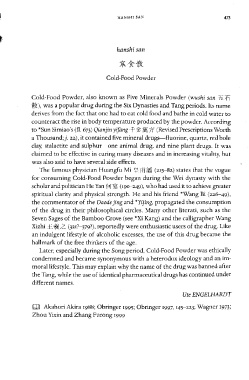Page 513 - The Encyclopedia of Taoism v1_A-L
P. 513
HANSHI SAN 473
,.
hanshi san
Cold-Food Powder
Cold-Food Powder, also known as Five Minerals Powder (wushi san liE
~)(), was a popular drug during the Six Dynasties and Tang periods. Its name
derives from the fact that one had to eat cold food and bathe in cold water to
counteract the rise in body temperature produced by the powder. According
to *Sun Simiao's (fl. 673) Qianjin yifang f.1: ~ 1J (Revised Prescriptions Worth
a Thousand;j. 22), it contained five mineral drugs-fluorine, quartz, red bole
clay, stalactite and sulphur-one animal drug, and nine plant drugs. It was
claimed to be effective in curing many diseases and in increasing vitality, but
was also said to have several side effects.
The famous physician Huangfu Mi .~ mi'i£i: (215-82) states that the vogue
for consuming Cold-Food Powder began during the Wei dynasty with the
scholar and politician He Yan {!if ~ (190-249), who had used it to achieve greater
spiritual clarity and physical strength. He and his friend *Wang Bi (226-49),
the commentator of the Daode jing and *Yijing, propagated the consumption
of the drug in their philosophical circles. Many other literati, such as the
Seven Sages of the Bamboo Grove (see *Xi Kang) and the calligrapher Wang
Xizhi.:E flz (321?-379?), reportedly were enthusiastic users of the drug. Like
an indulgent lifestyle of alcoholic excesses, the use of this drug became the
hallmark of the free thinkers of the age.
Later, especially during the Song period, Cold-Food Powder was ethically
condemned and became synonymous with a heterodox ideology and an im-
moral lifestyle. This may explain why the name of the drug was banned after
the Tang, while the use of identical pharmaceutical drugs has continued under
different names.
Ute ENGELHARDT
m Akahori Akira 1988; Obringer 1995; Obringer 1997, 145-223; Wagner 1973;
Zhou Yixin and Zhang Furong 1999

